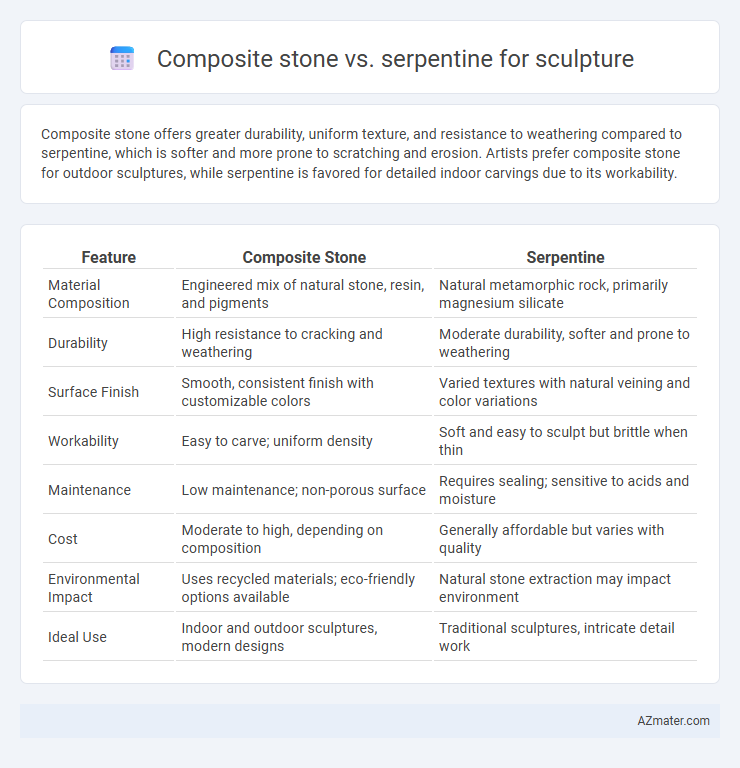Composite stone offers greater durability, uniform texture, and resistance to weathering compared to serpentine, which is softer and more prone to scratching and erosion. Artists prefer composite stone for outdoor sculptures, while serpentine is favored for detailed indoor carvings due to its workability.
Table of Comparison
| Feature | Composite Stone | Serpentine |
|---|---|---|
| Material Composition | Engineered mix of natural stone, resin, and pigments | Natural metamorphic rock, primarily magnesium silicate |
| Durability | High resistance to cracking and weathering | Moderate durability, softer and prone to weathering |
| Surface Finish | Smooth, consistent finish with customizable colors | Varied textures with natural veining and color variations |
| Workability | Easy to carve; uniform density | Soft and easy to sculpt but brittle when thin |
| Maintenance | Low maintenance; non-porous surface | Requires sealing; sensitive to acids and moisture |
| Cost | Moderate to high, depending on composition | Generally affordable but varies with quality |
| Environmental Impact | Uses recycled materials; eco-friendly options available | Natural stone extraction may impact environment |
| Ideal Use | Indoor and outdoor sculptures, modern designs | Traditional sculptures, intricate detail work |
Introduction to Sculptural Materials
Composite stone offers versatility for sculptors with its engineered blend of natural stone fragments and resin, providing durability and ease of carving. Serpentine, a naturally occurring metamorphic rock, is prized for its rich, varied coloration and smooth texture, making it ideal for polished sculptures. Both materials serve distinct artistic purposes, with composite stone favored for structural strength and serpentine valued for aesthetic appeal.
What is Composite Stone?
Composite stone is an engineered material made by combining natural stone aggregates with resin binders, offering enhanced durability and versatility compared to natural stone alone. It provides consistent texture and color, making it ideal for detailed sculptures requiring precision and resilience. In contrast, serpentine, a naturally occurring stone, is softer and prone to weathering, limiting its use in outdoor or high-wear sculptural applications.
Understanding Serpentine Stone
Serpentine stone, renowned for its rich green hues and smooth texture, offers excellent workability and durability, making it a favored choice for intricate sculptures. Its natural resistance to weathering enhances the longevity of outdoor artworks compared to composite stone, which often combines resin and natural minerals for increased consistency but may lack the unique veining and organic feel of serpentine. Sculptors prioritize serpentine for its aesthetic appeal and traditional use, while composite stone provides versatility and cost-effectiveness in large-scale or experimental projects.
Key Physical Properties Compared
Composite stone offers enhanced durability and resistance to weathering compared to serpentine, which is softer and more prone to scratching and chipping. Serpentine's fine-grain texture and natural veining provide superior aesthetic appeal, while composite stone's engineered consistency ensures uniformity and ease of carving. Density differences highlight serpentine's lower weight, making it preferable for intricate sculptures requiring detailed work, whereas composite stone supports larger, more robust installations.
Workability for Artists
Composite stone offers superior workability for artists due to its consistent texture and ease of carving with standard tools, allowing precise detailing and smooth finishes. Serpentine, while valued for its unique veining and natural coloration, presents challenges because of its variable hardness and tendency to chip, requiring specialized techniques and careful handling. Artists often prefer composite stone for intricate sculptures demanding fine craftsmanship, whereas serpentine suits larger, more organic forms that emphasize natural beauty.
Durability and Longevity
Composite stone offers superior durability due to its engineered composition, which enhances resistance to weathering, chipping, and erosion, making it ideal for long-lasting sculptures. Serpentine, a natural stone with a softer structure, is more susceptible to wear and environmental damage, reducing its longevity in outdoor or high-traffic installations. Sculptors seeking extended preservation favor composite stone for its consistent strength and minimal maintenance requirements compared to serpentine's natural variability and vulnerability.
Aesthetic Qualities and Color Options
Composite stone offers a consistent texture and a wide range of vibrant color options, making it ideal for sculptures requiring uniformity and bold visual impact. Serpentine, valued for its natural veining and subtle color variations ranging from deep greens to creamy whites, provides a unique, organic aesthetic that enhances the tactile appeal of sculptures. The choice between composite stone and serpentine depends on the desired balance between controlled color precision and naturally occurring patterns.
Cost and Availability
Composite stone offers a cost-effective alternative to serpentine, often priced significantly lower due to its engineered nature and widespread manufacturing. Serpentine, a natural stone prized for its unique veining and smooth texture, tends to be more expensive and less readily available in large blocks suitable for sculpture. The availability of composite stone is generally higher, with consistent supply from multiple manufacturers, while serpentine's limited quarry locations can lead to scarcity and increased costs for sculptors.
Environmental Impact of Each Material
Composite stone, made from resin and crushed natural stone, generally has a lower environmental impact than serpentine due to reduced quarrying and energy consumption during production. Serpentine, a natural mineral, involves extensive mining, which can lead to habitat disruption and higher carbon emissions from extraction and transportation. Both materials require careful sourcing and disposal to minimize ecological footprint, but composite stone offers more sustainable options with recycled content and lower resource intensity.
Choosing the Right Stone for Your Sculpture
Composite stone offers versatility with consistent texture and enhanced durability, making it ideal for detailed and long-lasting sculptures. Serpentine, prized for its rich color variations and smooth carving qualities, provides a natural, unique finish favored by sculptors seeking organic aesthetics. Selecting the right stone depends on the desired finish, durability requirements, and the complexity of the sculpture design.

Infographic: Composite stone vs Serpentine for Sculpture
 azmater.com
azmater.com